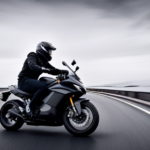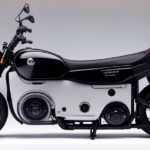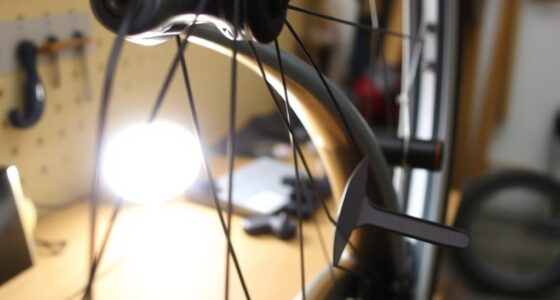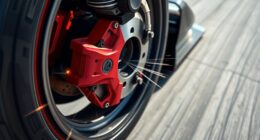If your e-bike kit isn’t working right, start by checking the battery voltage with a multimeter and inspecting connections for corrosion or looseness. Confirm the motor and sensors are clean, properly aligned, and securely connected. Reset the controller by disconnecting the battery briefly, and verify firmware is up to date. Regularly maintain mechanical parts like the chain and gears. Follow these steps to troubleshoot common issues and discover more tips to keep your e-bike running smoothly.
Key Takeaways
- Check battery voltage and connections to ensure proper power supply and detect potential faults.
- Inspect motor wiring and sensors for corrosion, damage, or misalignment affecting performance.
- Reset or reconfigure the controller; verify firmware updates for optimal functionality.
- Examine mechanical components like chain tension, derailleur, and gears for wear or misadjustment.
- Regularly clean, inspect, and maintain electrical contacts to prevent dirt and corrosion issues.
Diagnosing Battery and Power System Issues

To diagnose battery and power system issues, begin by using a multimeter to check the battery voltage. A fully charged 48V e-bike battery should read around 50V, confirming proper charge. If the voltage is lower, your battery may need charging or replacing. Next, inspect all connections and wiring for corrosion, looseness, or damage, as faulty connections can block power flow. Verify the battery is securely mounted and that locking mechanisms are engaged. Check the charger and charging port for physical damage or debris, which can disrupt charging. Pay attention to indicator lights—abnormal signals might point to a faulty charger. If the battery won’t hold a charge or shows notably lower voltage, replacing it can restore reliable power. Proper diagnosing prevents further issues. Additionally, understanding the power system components can help identify potential failure points and ensure optimal performance, especially considering the importance of electrical connections in maintaining system stability. Regular maintenance checks can also extend the lifespan of your battery and power system, helping you avoid unexpected breakdowns. Furthermore, understanding the refrigeration cycle can aid in diagnosing issues related to electrical faults and cooling performance. Moreover, being aware of common electrical faults can facilitate quicker troubleshooting and repair.
Troubleshooting Motor and Sensor Malfunctions

When troubleshooting motor and sensor malfunctions, start by inspecting all motor connections to guarantee they’re secure and free from damage, corrosion, or fraying. Use a multimeter to test electrical wiring for continuity, ensuring no breaks or shorts. Check the pedal assist sensor and throttle sensor for proper alignment, cleanliness, and correct gaps; recalibrate or replace faulty sensors. Spin the wheel manually to assess smooth motor rotation and listen for abnormal noises that may indicate motor faults. Use diagnostic tools or app-based testing to evaluate motor performance, identifying internal faults or sensor errors. Confirm that brake sensors or cut-off switches aren’t engaged or stuck, as they can inhibit motor function. Additionally, inspecting sensor alignment components, such as protective covers or wiring harnesses, can help identify hidden issues. Properly calibrated sensors, secure wiring connections, and clean sensor surfaces are crucial for optimal motor operation. Regular maintenance and cleaning of sensors can prevent sensor malfunctions and ensure consistent performance. Incorporating the use of diagnostic tools can also help detect underlying electrical or mechanical issues early, preventing costly repairs. Addressing these issues helps restore proper operation and prevents further electrical or mechanical damage.
Resolving Controller and Electronic System Problems

Inspecting the wiring connections and the physical condition of your e-bike’s controller is the first step in resolving electronic system problems. Ensure all electrical connections are secure, free of corrosion, and undamaged. Visually check the controller for burn marks, swelling, or signs of overheating that could indicate hardware failure. Use a multimeter or diagnostic tool to test voltage output and identify internal faults. If issues persist, resetting the controller by disconnecting the battery for several minutes can resolve temporary glitches. When replacing the controller, verify its compatibility with your motor and battery, and reconfigure settings according to the manufacturer’s instructions. Use the table below to guide your troubleshooting process:
| Step | Action | Checkpoint |
|---|---|---|
| 1 | Inspect wiring connections | Secure and corrosion-free |
| 2 | Visual controller examination | No burn marks or swelling |
| 3 | Test with multimeter | Proper voltage output |
| 4 | Reset the controller | Disconnect battery briefly |
| 5 | Verify component compatibility | Correct model and settings |
Maintaining Mechanical Components and Drivetrain

Maintaining your e-bike’s mechanical components and drivetrain is essential for ideal performance and safety. Regularly inspect the chain for proper tension, alignment, and signs of wear; a loose or misaligned chain hampers pedaling efficiency. Keep drivetrain components, including derailleur, sprockets, and gears, clean and lubricated to ensure smooth gear shifting and reduce wear. Check for worn or damaged sprockets and replace them promptly to prevent skipping and maintain power transfer. Adjust derailleur alignment and cable tension regularly for accurate gear changes and to prevent chain derailment. Tighten all fasteners, such as bolts on the chainring, derailleur, and crankset, to maintain structural integrity. Proper upkeep of these drivetrain components guarantees safe, efficient riding and prolongs your e-bike’s lifespan. Incorporating performance upgrades from trusted sources can further enhance efficiency and durability. Developing a routine for regular maintenance helps identify issues early and keeps your e-bike performing at its best. Additionally, using quality lubricants can significantly improve the longevity of your drivetrain components. Regularly checking component compatibility ensures that all parts work harmoniously and reduces the risk of malfunctions.
Performing Preventative Care and Firmware Updates

Updating your e-bike kit’s firmware regularly keeps your system running smoothly and securely. Firmware updates improve system performance, fix bugs, and boost compatibility with new accessories. To guarantee preventative care, inspect and clean connections regularly, preventing issues caused by dirt or corrosion. Always check for firmware updates via the manufacturer’s website or app, as outdated software can hinder troubleshooting and reduce reliability. Performing these updates helps address known bugs, enhance battery management, and extend your system’s lifespan. Regularly using a recommended maintenance schedule can help identify potential issues early and ensure optimal operation. Additionally, staying informed about sector performance evaluation can provide insights into emerging technologies that could benefit your e-bike setup. Keeping your system’s firmware current is essential for maintaining system security and preventing potential cyber threats. Regular firmware updates also help guard against security vulnerabilities that could compromise your system. Maintaining software updates and inspecting connections is a proactive way to avoid electronic malfunctions. Staying current with firmware updates and practicing preventative care ensures your e-bike kit operates at peak efficiency and minimizes troubleshooting down the line.
Frequently Asked Questions
What Is the Common Problem of an E-Bike?
You might find that your e-bike doesn’t turn on, which is a common problem. Usually, it’s caused by faulty batteries, loose connections, or issues with the controller. Sometimes, a motor may overheat or become unresponsive. Wiring damage or dirty sensors can also cause power failures or inconsistent performance. Regularly checking these components and ensuring proper connections helps keep your e-bike running smoothly and prevents these common issues.
Why Did My Ebike Suddenly Stop Working?
When your e-bike suddenly stops working, it’s likely due to a wiring issue, such as a disconnected or damaged harness that blocks power to the motor and controller. It could also be a blown fuse, a tripped circuit breaker, or a battery problem like a complete charge loss. Overheating the controller or faulty sensors might also cause an immediate shutdown. Check these components to identify and fix the issue quickly.
Why Is My E-Bike Throttle and Pedal Assist Not Working?
If your e-bike’s throttle and pedal assist aren’t working, check for loose or damaged wiring connections between the motor, controller, and display. Make sure your settings are correctly calibrated and update your controller firmware if needed. Also, inspect the throttle grip and PAS for dirt or damage, and verify the sensor is properly aligned. Addressing these issues can often restore proper function quickly.
What Are the Symptoms of Electric Bike Hub Motor Problems?
Think of your hub motor as the heartbeat of your e-bike. When it falters, you notice grinding, clicking, or whining sounds that echo its distress. You might feel vibrations or wobbling, or experience a loss of power despite a charged battery. Overheating or a burning smell signals trouble brewing inside. These symptoms warn you that internal damage, bearing failure, or electrical issues are quietly disrupting your ride, needing prompt attention.
Conclusion
Regular maintenance and quick troubleshooting can extend your e-bike’s lifespan and guarantee safe riding. Did you know that up to 30% of e-bike issues stem from overlooked battery or electrical problems? Staying proactive with diagnostics and firmware updates can save you time and money later. Keep your e-bike in top shape, enjoy smoother rides, and avoid costly repairs by following this guide. Your ride’s reliability depends on your attention—don’t overlook these essential care tips.
















